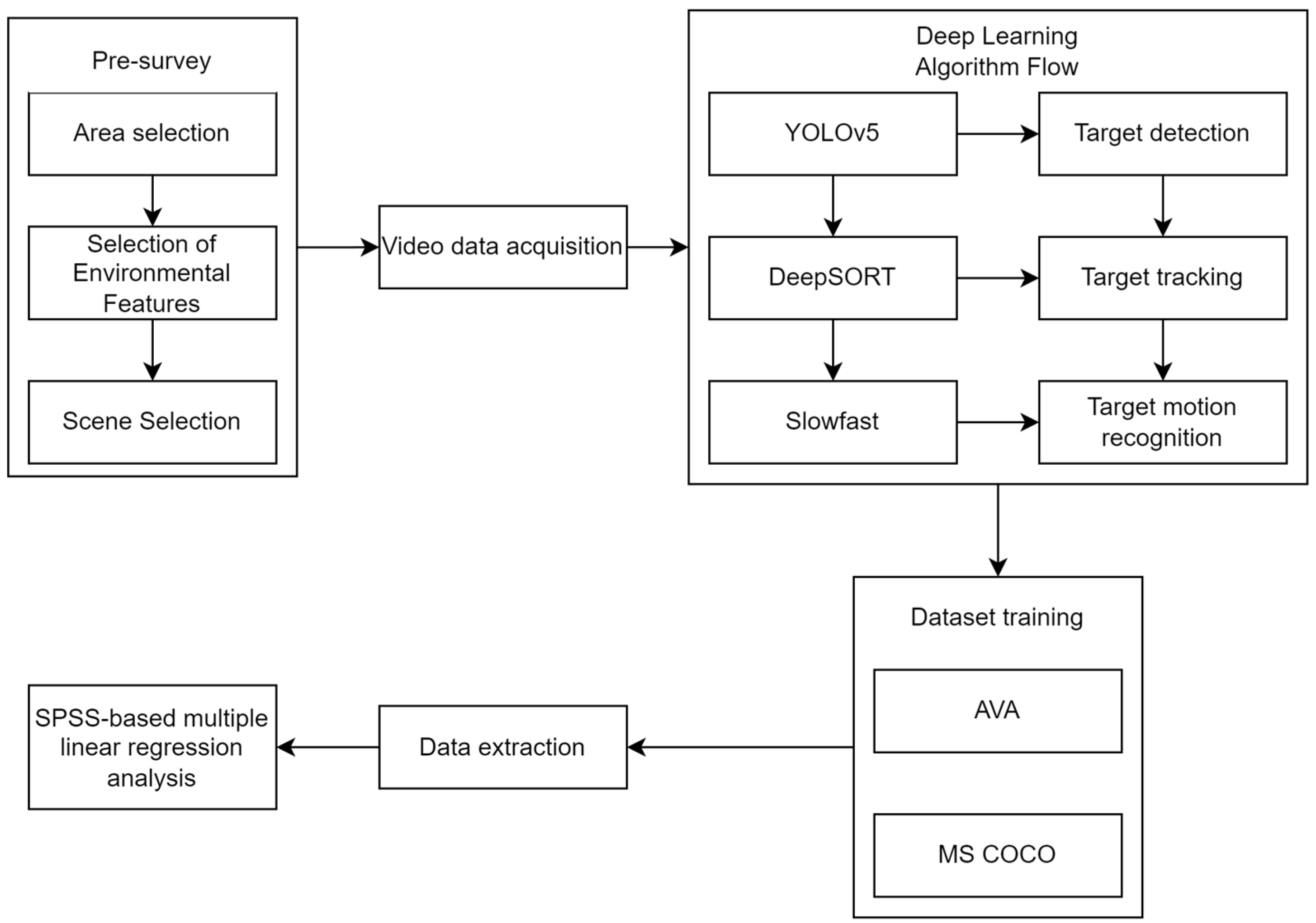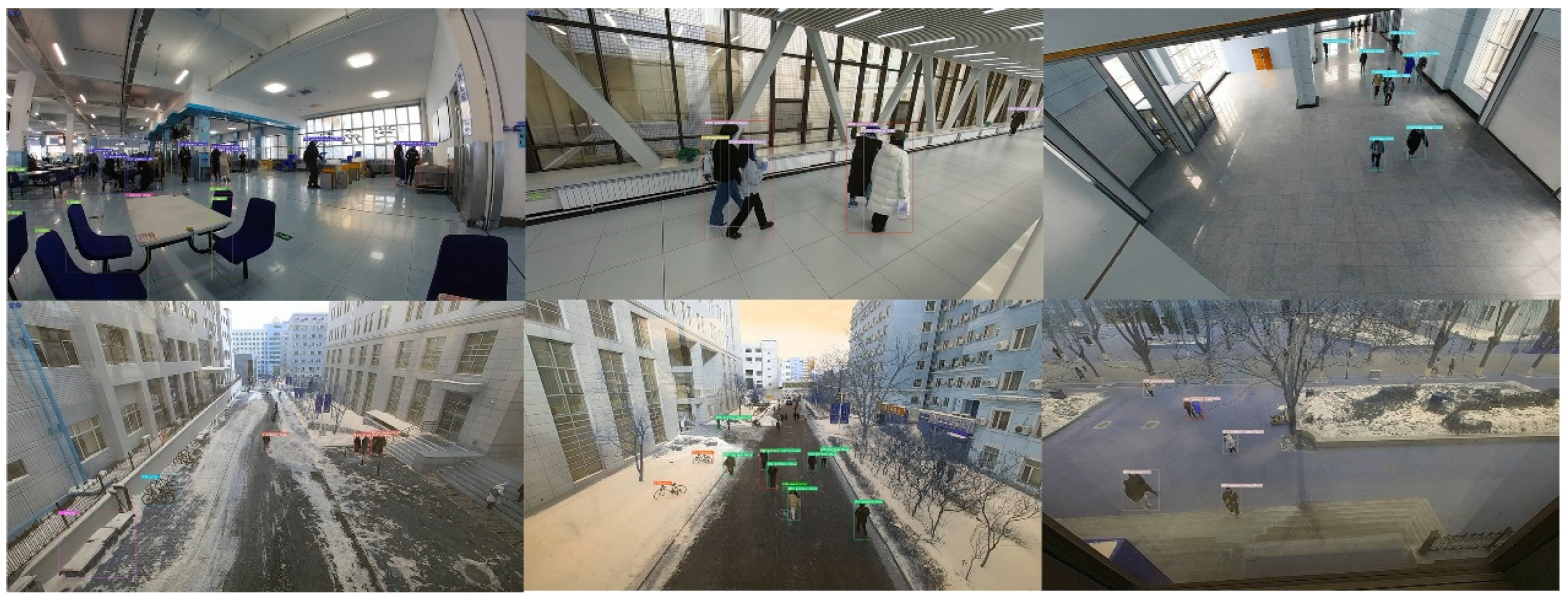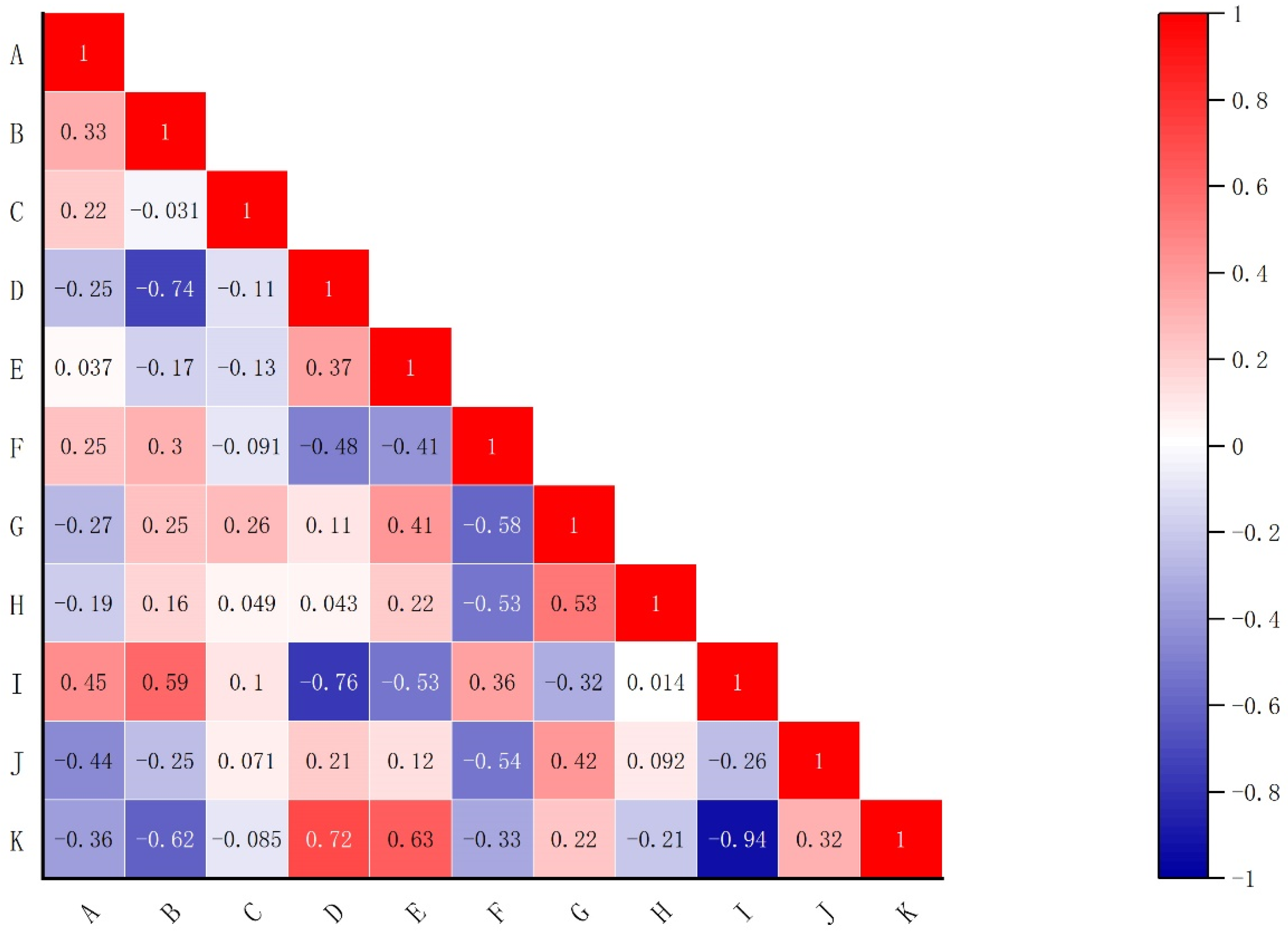Characterizing the Supportive Environment of Informal Spaces on Cold Region University Campuses to Enhance Social Interaction Behavior
Abstract
1. Introduction
1.1. Background and Significance
1.2. Literature Review
1.3. Research Issues
2. Methodology
2.1. Workflow
2.2. Research Area
2.3. Feature Selection
2.4. Research Tools
2.5. Data Extraction
3. Results
3.1. Descriptive Statistics and Correlation
3.2. Effect of Variables on Social Interaction Behavior
4. Discussion
4.1. Effects of Environmental Functional Characteristics on Social Interaction Behavior
4.2. Effects of Physical Features of the Environment on Social Interaction Behavior
4.3. Limitations and Future Research Directions
- (1)
- The videos were acquired in the same region. Although they represent the characteristics of crowd activities in the climatic conditions of this cold region, they may not be representative of crowd activities in other cold-region areas. Future research could expand the study areas to other climate zones based on the Köppen–Geiger climate classification and compare the characteristics of different regions to enhance the reliability of the findings.
- (2)
- The deep learning model could only detect certain crowd behaviors and spatial categories. Thus, we classified the behaviors into walking, standing, sitting, and interacting. Future research should investigate different behaviors, utilize additional models, and optimize the datasets.
- (3)
- Winter clothing is thick, and the face is obscured. Therefore, it was impossible to detect social interactions based on facial expressions. We used only the relative positions of people to infer social interactions. Future studies could incorporate facial expressions, characteristic movements, interaction positions, and other features to infer social interactions and improve recognition efficiency.
- (4)
- The videos were recorded during the midday hours in good lighting to obtain a high recognition rate. Thus, we could not incorporate a time variable. Future research could assess the effect of different periods on social interactions.
5. Conclusions
Author Contributions
Funding
Data Availability Statement
Conflicts of Interest
References
- Rummel, R.J. Understanding Conflict and War: The Conflict Helix; Sage: New York, NY, USA, 1976; Volume 2. [Google Scholar]
- Bolger, N.; Eckenrode, J. Social Relationships, Personality, and Anxiety During a Major Stressful Event. J. Personal. Soc. Psychol. 1991, 61, 440. [Google Scholar] [CrossRef] [PubMed]
- Hirshberg, M.J.; Colaianne, B.; Inkelas, K.K.; Oke, G.; Van Doren, N.; Davidson, R.J.; Roeser, R.W. COVID-19 Pandemic Effects on College Student Mental Health: A Cross-Sectional Cohort Comparison Study. J. Am. Coll. Health 2023, 1, 1–10. [Google Scholar] [CrossRef] [PubMed]
- Kabo, F.W.; Cotton-Nessler, N.; Hwang, Y.; Levenstein, M.C.; Owen-Smith, J. Proximity Effects on the Dynamics and Outcomes of Scientific Collaborations. Res. Policy 2014, 43, 1469–1485. [Google Scholar] [CrossRef]
- Lee, H.J.; Szinovacz, M.E. Positive, Negative, and Ambivalent Interactions with Family and Friends: Associations with Well-being. J Marriage Fam. 2016, 78, 660–679. [Google Scholar] [CrossRef]
- Lange, P.A.M.V. Bridging social psychology. In Bridging Social Psychology: Benefits of Transdisciplinary Approaches; Lawrence Erlbaum Associates Publishers: Mahwah, NJ, USA, 2006; pp. 3–20. ISBN 978-0-8058-5094-9. [Google Scholar]
- Amabile, T.M. The Social Psychology of Creativity: A Componential Conceptualization. J. Personal. Soc. Psychol. 1983, 45, 357. [Google Scholar] [CrossRef]
- Perry-Smith, J.E.; Shalley, C.E. The Social Side of Creativity: A Static and Dynamic Social Network Perspective. Acad. Manag. Rev. 2003, 28, 89. [Google Scholar] [CrossRef]
- Ono, E.; Nozawa, T.; Ogata, T.; Motohashi, M.; Higo, N.; Kobayashi, T.; Ishikawa, K.; Ara, K.; Yano, K.; Miyake, Y. Relationship between social interaction and mental health. In Proceedings of the 2011 IEEE/SICE International Symposium on System Integration (SII), Kyoto, Japan, 20–22 December 2011; pp. 246–249. [Google Scholar]
- Lewis, M.A.; Rook, K.S. Social Control in Personal Relationships: Impact on Health Behaviors and Psychological Distress. Health Psychol. 1999, 18, 63–71. [Google Scholar] [CrossRef]
- Hurst, B.; Wallace, R.R.; Nixon, S.B. The Impact of Social Interaction on Student Learning; Missouri State University: Springfield, MO, USA, 2013. [Google Scholar]
- Xu, Y.; Yang, Y. Student Learning in Business Simulation: An Empirical Investigation. J. Educ. Bus. 2010, 85, 223–228. [Google Scholar] [CrossRef]
- Williams, K.B. Academic Support, Social Support, and Professional Development of Higher and Lower Achieving Psychology Majors. N. Am. J. Psychol. 2015, 17, 373–382. [Google Scholar]
- Osterholt, D.A.; Barratt, K. Ideas for Practice: A Collaborative Look to the Classroom. J. Dev. Educ. 2012, 36, 22. [Google Scholar]
- Mazumdar, S. Organisational Physical Environments: Environmental Reading, Communication and Embarrassment. ASBM J. Manag. 2008, 1, 1. [Google Scholar]
- Cerruti, M.S.; Shepley, M.M. The Effects of Spatial Enclosure on Social Interaction Between Older Adults with Dementia and Young Children. HERD Health Environ. Res. Des. J. 2016, 9, 63–81. [Google Scholar] [CrossRef] [PubMed]
- Cantero, J.M.M.; Mira, R.G.; López-Chao, V. Influence of Physical Learning Environment in Student’s Behavior and Social Relations. Anthropologist 2016, 25, 249–253. [Google Scholar] [CrossRef]
- Aliyu, U.D. An Overview of the Physical and Social Learning Environment of Nigerian Schools. Sokoto Educ. Rev. 2014, 15, 6. [Google Scholar] [CrossRef]
- Conn, S.A.; Conn, L.K. Ecopsychology and Psychotherapy Within the Larger Context: Response to Jack Aylward’s Article on Paul Goodman’s Legacy. Gestalt Rev. 1999, 3, 119–125. [Google Scholar] [CrossRef]
- Blair, L. Ecopsychology and the Person-Centred Approach: Exploring the Relationship. Couns. Psychol. Rev. 2011, 26, 43–52. [Google Scholar] [CrossRef]
- Panov, V.I.; Patrakov, E.V. Digitalization of the Information Environment in the Context of the Ecopsychological Model of the Formation of Subjectivity; Moscow State University of Psychology and Education: Moscow, Russia, 2013. [Google Scholar]
- Doherty, T.J. Ecopsychology Enters Its Second Year. Ecopsychology 2010, 2, 1–3. [Google Scholar] [CrossRef]
- Wilson, D.K.; Sweeney, A.M.; Kitzman-Ulrich, H.; Gause, H.; St. George, S.M. Promoting Social Nurturance and Positive Social Environments to Reduce Obesity in High-Risk Youth. Clin. Child Fam. Psychol. Rev. 2017, 20, 64–77. [Google Scholar] [CrossRef]
- Jayaratne, S.; Himle, D.; Chess, W.A. Dealing with Work Stress and Strain: Is the Perception of Support More Important than Its Use? J. Appl. Behav. Sci. 1988, 24, 191–202. [Google Scholar] [CrossRef]
- Holz, N.E.; Tost, H.; Meyer-Lindenberg, A. Resilience and the Brain: A Key Role for Regulatory Circuits Linked to Social Stress and Support. Mol. Psychiatry 2020, 25, 379–396. [Google Scholar] [CrossRef]
- Acton, R. Place-People-Practice-Process: Using Sociomateriality in University Physical Spaces Research. Educ. Philos. Theory 2017, 49, 1441–1451. [Google Scholar] [CrossRef]
- Nordtømme, S. Place, Space and Materiality for Pedagogy in a Kindergarten. Educ. Inq. 2012, 3, 317–333. [Google Scholar] [CrossRef]
- Heath, C. Configuring Action in Objects: From Mutual Space to Media Space. Mind Cult. Act. 2000, 7, 81–104. [Google Scholar] [CrossRef]
- Fan, M.; Jamaludin, A.A.; Hussein, H. The Observation of Sensory Design in Open Spaces of University Campus under Hot-Humid Climate. Environ.-Behav. Proc. J. 2020, 5, 117. [Google Scholar] [CrossRef]
- Beyraghi, S.; Balilan, L. Semiotics of Behavioral Settings in Educational Spaces, Emphasizing the Social Value of Spaces (Case Study of Islamic Art Faculty and Architecture and Art Faculty of Azad University of Tabriz). Int. J. Architect. Eng. Urban Plan 2018, 28, 117–133. [Google Scholar] [CrossRef]
- Wang, F. Research on the university campus space environment design from the perspective of behavioral psychology—Taking Qinhu and its surrounding environment as the example. In Proceedings of the 2017 2nd International Conference on Politics, Economics and Law (ICPEL 2017), Weihai, China, 28–29 July 2017; Atlantis Press: Weihai, China, 2017. [Google Scholar]
- Sun, D.; Looi, C.-K. An Inspiration from border crossing: Principle of boundary activity for integrating learning in the formal and informal spaces. In Seamless Learning; Looi, C.-K., Wong, L.-H., Glahn, C., Cai, S., Eds.; Lecture Notes in Educational Technology; Springer: Singapore, 2019; pp. 73–88. ISBN 9789811330704. [Google Scholar]
- Earl, C. Vietnam’s “Informal Public” Spaces: Belonging and Social Distance in Post-Reform Hồ Chí Minh City. J. Vietnam. Stud. 2010, 5, 86–124. [Google Scholar] [CrossRef]
- Cox, A.M. Space and Embodiment in Informal Learning. High Educ. 2018, 75, 1077–1090. [Google Scholar] [CrossRef]
- Hassi, J.; Rytkönen, M.; Kotaniemi, J.; Rintamäki, H. Impacts of Cold Climate on Human Heat Balance, Performance and Health in Circumpolar Areas. Int. J. Circumpolar Health 2005, 64, 459–467. [Google Scholar] [CrossRef] [PubMed]
- Johnston, D.W.; Knott, R.; Mendolia, S.; Siminski, P. Upside-Down Down-Under: Cold Temperatures Reduce Learning in Australia. Econ. Educ. Rev. 2021, 85, 102172. [Google Scholar] [CrossRef]
- Morris, D.M.; Pilcher, J.J. Psychological Response Not Physiological Response Predicts Aggression behind the Wheel during Cold Stress. Proc. Hum. Factors Ergon. Soc. Annu. Meet. 2015, 59, 1702–1706. [Google Scholar] [CrossRef]
- Eliasson, I.; Knez, I.; Westerberg, U.; Thorsson, S.; Lindberg, F. Climate and Behaviour in a Nordic City. Landsc. Urban Plan. 2007, 82, 72–84. [Google Scholar] [CrossRef]
- Pressman, N. Planning in Cold Climates: A Critical Overview of Canadian Settlement Patterns and Policies; The University of Winnipeg: Winnipeg, MB, Canada, 1986. [Google Scholar]
- Jull, M. Toward a Northern Architecture: The Microrayon as Arctic Urban Prototype. J. Archit. Educ. 2016, 70, 214–222. [Google Scholar] [CrossRef]
- Nazarian, N.; Acero, J.A.; Norford, L. Outdoor Thermal Comfort Autonomy: Performance Metrics for Climate-Conscious Urban Design. Build. Environ. 2019, 155, 145–160. [Google Scholar] [CrossRef]
- Yilmaz, S.; Mutlu, E.; Yilmaz, H. Alternative Scenarios for Ecological Urbanizations Using ENVI-Met Model. Environ. Sci. Pollut. Res. 2018, 25, 26307–26321. [Google Scholar] [CrossRef]
- Liao, E.N.; Chehab, L.Z.; Ossmann, M.; Alpers, B.; Patel, D.; Sammann, A. Using Architectural Mapping to Understand Behavior and Space Utilization in a Surgical Waiting Room of a Safety Net Hospital. Int. J. Environ. Res. Public Health 2022, 19, 13870. [Google Scholar] [CrossRef] [PubMed]
- Wang, X.; Wu, C. An Observational Study of Park Attributes and Physical Activity in Neighborhood Parks of Shanghai, China. Int. J. Environ. Res. Public Health 2020, 17, 2080. [Google Scholar] [CrossRef]
- Yan, W.; Forsyth, D.A. Learning the behavior of users in a public space through video tracking. In Proceedings of the 2005 Seventh IEEE Workshops on Applications of Computer Vision (WACV/MOTION’05), Breckenridge, CO, USA, 5–7 January 2005; Volume 1, pp. 370–377. [Google Scholar]
- Peel, M.C.; Finlayson, B.L.; McMahon, T.A. Updated World Map of the Koppen-Geiger Climate Classification. Hydrol. Earth Syst. Sci. 2007, 11, 1633–1644. [Google Scholar] [CrossRef]
- Gu, C.; Sun, C.; Ross, D.A.; Vondrick, C.; Pantofaru, C.; Li, Y.; Vijayanarasimhan, S.; Toderici, G.; Ricco, S.; Sukthankar, R.; et al. AVA: A video dataset of spatio-temporally localized atomic visual actions. In Proceedings of the 2018 IEEE/CVF Conference on Computer Vision and Pattern Recognition, Salt Lake City, UT, USA, 18–23 June 2018; pp. 6047–6056. [Google Scholar]
- Lin, T.-Y.; Maire, M.; Belongie, S.; Bourdev, L.; Girshick, R.; Hays, J.; Perona, P.; Ramanan, D.; Zitnick, C.L.; Dollár, P. Microsoft COCO: Common Objects in Context 2015. In Proceedings of the Computer Vision–ECCV 2014: 13th European Conference, Zurich, Switzerland, 6–12 September 2014. [Google Scholar]
- Kim, H.; Yang, S. Neighborhood Walking and Social Capital: The Correlation between Walking Experience and Individual Perception of Social Capital. Sustainability 2017, 9, 680. [Google Scholar] [CrossRef]
- Zurawik, M. Moving through Spaces—Leisure Walking and Its Psychosocial Benefits for Well-Being: A Narrative Review. Hum. Mov. 2020, 21, 1–8. [Google Scholar] [CrossRef]
- Doughty, K. Walking Together: The Embodied and Mobile Production of a Therapeutic Landscape. Health Place 2013, 24, 140–146. [Google Scholar] [CrossRef]
- Mondada, L. Emergent Focused Interactions in Public Places: A Systematic Analysis of the Multimodal Achievement of a Common Interactional Space. J. Pragmat. 2009, 41, 1977–1997. [Google Scholar] [CrossRef]
- Wessolowski, N.; Koenig, H.; Schulte-Markwort, M.; Barkmann, C. The Effect of Variable Light on the Fidgetiness and Social Behavior of Pupils in School. J. Environ. Psychol. 2014, 39, 101–108. [Google Scholar] [CrossRef]
- Aan Het Rot, M.; Moskowitz, D.S.; Young, S.N. Exposure to Bright Light Is Associated with Positive Social Interaction and Good Mood over Short Time Periods: A Naturalistic Study in Mildly Seasonal People. J. Psychiatr. Res. 2008, 42, 311–319. [Google Scholar] [CrossRef] [PubMed]






Disclaimer/Publisher’s Note: The statements, opinions and data contained in all publications are solely those of the individual author(s) and contributor(s) and not of MDPI and/or the editor(s). MDPI and/or the editor(s) disclaim responsibility for any injury to people or property resulting from any ideas, methods, instructions or products referred to in the content. |
© 2024 by the authors. Licensee MDPI, Basel, Switzerland. This article is an open access article distributed under the terms and conditions of the Creative Commons Attribution (CC BY) license (https://creativecommons.org/licenses/by/4.0/).
Share and Cite
Chen, J.; Shi, H.; Pan, W.; Sun, D. Characterizing the Supportive Environment of Informal Spaces on Cold Region University Campuses to Enhance Social Interaction Behavior. Buildings 2024, 14, 1529. https://doi.org/10.3390/buildings14061529
Chen J, Shi H, Pan W, Sun D. Characterizing the Supportive Environment of Informal Spaces on Cold Region University Campuses to Enhance Social Interaction Behavior. Buildings. 2024; 14(6):1529. https://doi.org/10.3390/buildings14061529
Chicago/Turabian StyleChen, Jianfei, Hedi Shi, Wente Pan, and Donghui Sun. 2024. "Characterizing the Supportive Environment of Informal Spaces on Cold Region University Campuses to Enhance Social Interaction Behavior" Buildings 14, no. 6: 1529. https://doi.org/10.3390/buildings14061529
APA StyleChen, J., Shi, H., Pan, W., & Sun, D. (2024). Characterizing the Supportive Environment of Informal Spaces on Cold Region University Campuses to Enhance Social Interaction Behavior. Buildings, 14(6), 1529. https://doi.org/10.3390/buildings14061529






